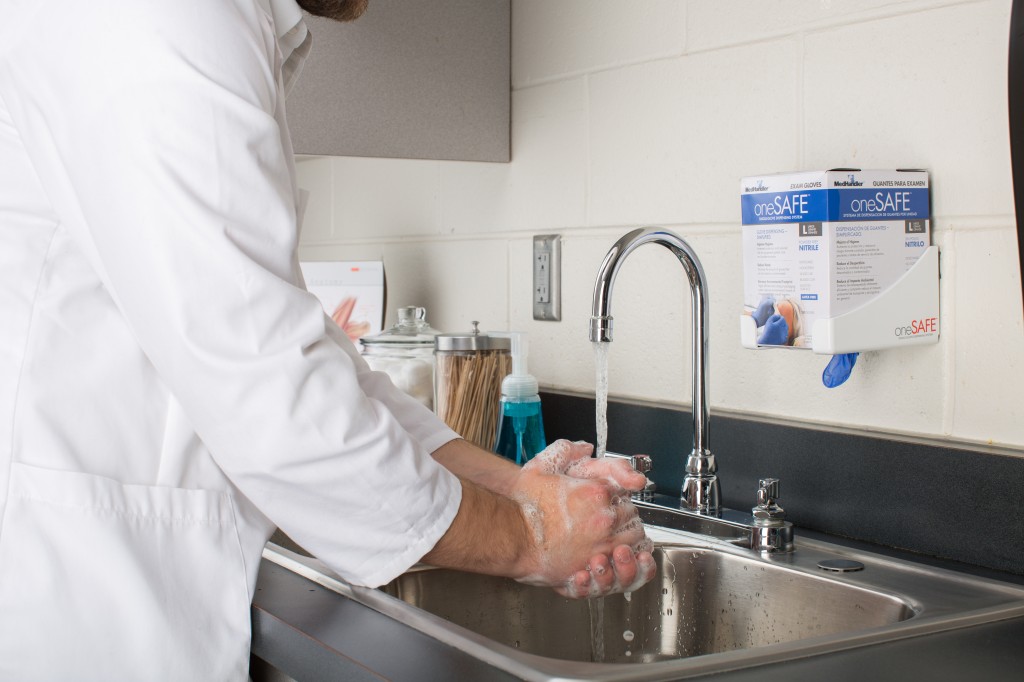The Physical Elements of Food Service Hand Hygiene – Part I
 September is National Food Safety Education Month and the theme has a rhyme to it – “Keep Hands Clean with Good Hygiene”. Hand washing is one of the public’s best defenses against the spread of both common and rare, even life-threatening, diseases including those caused by food, and against gastrointestinal infections caused by such organisms as the Norovirus, which plagues the cruise ship industry and food service in general.
September is National Food Safety Education Month and the theme has a rhyme to it – “Keep Hands Clean with Good Hygiene”. Hand washing is one of the public’s best defenses against the spread of both common and rare, even life-threatening, diseases including those caused by food, and against gastrointestinal infections caused by such organisms as the Norovirus, which plagues the cruise ship industry and food service in general.
Unfortunately, it’s not just as simple as saying I wash my hands like my mamma told me to. Every hand washing study out there shows that hand washing compliance is somewhere between 50-85% actually doing the deed—not very good news. Food service managers must consider all the hand hygiene elements and work to keep them in place to make improvements in the actual behavior of food workers associated with their hand washing practices. Hand hygiene elements are: 1) the physical equipment and tools to wash hands with; 2) the knowledge about the specific details of hand washing. Engage your employees in effective hand washing through knowledge. Educate and train them on the risks, the law, best practices and, most importantly, their personal role in serving safe food to all customers.
The Physical Hand Washing Elements– the optimum kitchen layout supports the importance of food safety in the hand hygiene process. Sometimes in older kitchens, handsinks are not strategically placed, well designed or well equipped, but work towards improvements no matter how small.
- Hand Sinks – Are the hand sinks close to each work area? Food or 3 compartment sinks cannot be used. Hand sinks should have deep wells, side splash guards if right next to food production, and preferably made of #304 stainless steel with seamless construction. If remodeling or upgrading, consider all “hands-free” — gooseneck faucets, paper towel and soap dispensers. Hand washing signs are required in the Food Code. Visit the Tools and Resources page for signage you can use!
- Soap & Hand Sanitizer—All soaps and hand sanitizers are not created equal. Talk to suppliers and try out formulations (gel, liquid or foam) to get best efficacy for removing pathogens and the kindness to the skin, rather than just buying the cheapest product. Warm water temperature can help the soap work better and encourage the frequency. Antibacterial soaps are not essential for good hand washing and do not kill viruses. A good mild soap with plenty of friction when you lather up removes the most pathogens. The best soap packaging is a bagged, airless system. A great new tool equips the soap dispensers with a digital usage counters (to monitor how many handwashes are done per day). Another good practice is having two soap dispensers at each sink to create a “never out” system. Alcohol hand sanitizers are okay if formulated correctly with skin softening emollients. They do kill bacteria fairly well, but are not effective on viruses and do dry the skin surface. Hand sanitizers never replace the hand washing practice and the Food Code requires a hand wash first before using.
- Nailbrushes or the “Claw Paw” – Fingertips, under nails, and between fingers are the source of most contamination on the hands—particularly after a restroom visit. It makes sense – almost everything we touch in kitchens is with fingertips. Studies have shown that nailbrushes create friction and dramatically enhance contaminant removal during hand washing. Controversy still exists about how to store the nailbrush in a sanitary manner. Tether it to the sink. Use a soft bristle nailbrush that has fused bristles (rather than common stapled bristles) so bacteria can’t lodge in it. If you choose not to use a nailbrush, teach food workers to use the “claw paw” by bending fingertips into the opposite palm when lathering hands.
- Paper Towels – Air dryers in kitchens are not a good option. Single-use paper towels, are the clearly the best for hand drying in the fast paced professional food handling environment. They are both effective and fast, the two critical elements of choice. Science shows us drying hands well after hand washing, removes additional levels of bacteria just from the friction.
- Gloves & Utensils – Multiple barriers to avoid touching foods with hands is a good thing. The Food Code recommends “no bare hand contact with ready-to-eat foods.” Proper use of quality, single-use, food contact gloves can significantly lower the risk of foodborne illness. Use NSF certified gloves and use the right glove for the task. Gloves and utensils deliver an added level of protection and provide a visual cue to customers that the establishment cares about their well being.
Bottom Line: Get your hand hygiene “risk control plan” started and working at your facility to improve handwashing compliance. This type of plan has been identified as an effective strategy for affecting long-term behavioral changes for food workers.
***
About the Author: Lacie Thrall

This information is provided as a general guideline and is not intended to be, nor does it, constitute legal or regulatory advice. Additional Federal regulations may apply to your particular circumstances. State, regional and local laws, ordinances and regulations may also apply.
Handling Leafy Green Salad
We have had several produce outbreaks of foodborne disease from our lettuce, spinach, and other greens in the last several years that have been devastating to the produce growers and distributors, retail grocery stores, restaurants, and consumers.
Food Packaging Safety in a Vacuum
Extending the shelf life of fresh foods has come a long way in the food industry since curing meats with salt and sugar or canning vegetables with heat processing. The food service and consumer markets needed some better visual packages to draw the eye to the freshness factor and the technology of food packaging has filled our dinner plate. Vacuum packaging and modified atmosphere packaging, shortened to “MAP”, are the terms used for the method of food packaging used every time we choose convenience over more complex scratch meal preparation. According to industry statistics, billions of packages of vacuum and MAP-packaged foods flood the marketplace today. In both modified-atmosphere and vacuum packaging, food is packaged in a pouch made of barrier film.
The Eleven Commandments of Food Safety at Your Restaurant
Lists help us remember all kinds of information. Given the list of recent national foodborne outbreaks in the news, keep repeating this list to your food service team. They are kind of like “commandments”. As a professional in a food service facility we should think of the very basic food safety concepts that every crew member should aspire to learn, even though this list may have different priorities based on your menu. The first 3 apply to anyone who serves food, from a bag of popcorn to a full course meal. As chefs or managers, if we can “set the example” by repeating good food safety practices visibly to the crew, it will help them understand how important it is to the success of your facility. Thou shalt:
The Worst Customer Complaint: Foodborne Illness
Food service managers and crew try to follow the rules of food protection. Yet, occasionally a complaint may arise and these calls take priority over all other daily crises. If you have been in the food service industry long enough, you may have gotten one of these. A customer may claim, "I think your food made me ill." These words inflict instant anxiety. If it happens, here are some next steps to think about in advance of such a claim:











